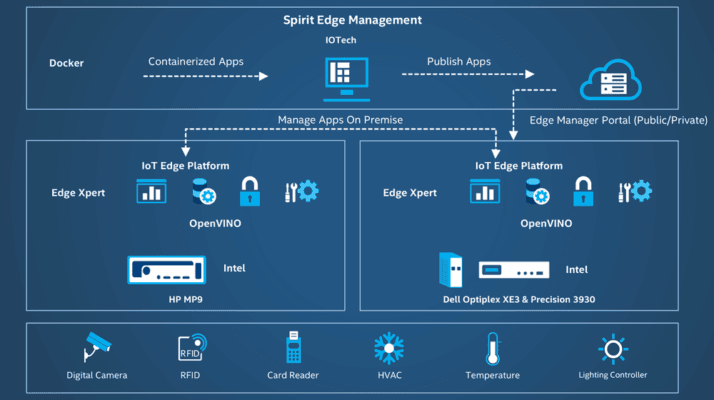Retail Data Comes Together at the In-Store Edge

Retailers are under tremendous pressure today. Keep up with the ecommerce giants or lose. But just how to do that is another issue. Technology upgrades are a must, but with so many choices—in the technologies themselves and in the vendors providing them—navigating the ecosystem is difficult.
And once the decision to invest has been made, there are other challenges. New solutions, the ones that use advanced retail analytics to provide new, real-time insights, are the holy grail. But how can retailers integrate them with legacy systems (sometimes from a host of different vendors) without disrupting existing operations or incurring exorbitant expense?
The answer is at the edge, where, thanks to open standards and powerful computing, systems integrators can blend different ingredients and data streams into one seamless, end-to-end solution.
Integrating Retail Data Streams
The IoT Edge Computing Platform from IOTech Systems Limited allows retailers and system integrators to take advantage of these new technologies and deploy solutions quickly.
“Our platform enables SIs to integrate best-in-class devices and combine a range of retail applications into an integrated, data-driven solution,” said Andy Foster, product director at IOTech Systems. “And even more importantly, it allows you to augment existing systems that are already in place rather than replace them.” Which means retailers can easily bring new ingredients into their environment.
It also allows for easy orchestration and management of applications deployed on edge nodes. So new capabilities can be added to the system, or existing capabilities upgraded, at scale and across retail environments (Figure 1).

Retail Analytics at the Edge
For reasons to do with latency, system responsiveness, data privacy, and limits on network bandwidth, the retail edge has become a focal point for innovation among software and hardware vendors. “After all, it’s at the edge where merging data from devices like point-of-sale hardware, RFID scanners, and smart cameras makes the most sense,” noted Foster.
And new use cases naturally follow. For example, in a loss prevention scenario, device data can be collected and fed into the analytics applications on edge nodes—capturing events and reporting anomalies in real time. Notifications of any suspicious activities can be automatically sent to an employee who can then take required action without interrupting the customer checkout process. In contrast, if all of this disparate data had to be fed to the analytics running in the cloud, the ability to take immediate action would be severely inhibited.
And edge computing is helping retailers better allocate staff. Smart video can track how long the lines are in a store and notify managers when help is needed. And retailers can gain important insights about customer behavior. Where are they spending the most time? Are they finding what they need quickly, or are they dwelling in certain aisles, confused? The answers to those questions inevitably lead to service improvements and happier customers.
Rather than writing vast lines of new code, integrating different devices to cloud endpoints or bringing applications onto the @iotechsystems platform is only a configuration exercise.
Streamlining Deployments
To deliver these solutions involves a collaboration among the retailer, its device and equipment providers, and the systems integrator (SI) to pull all of the ingredients together into an end-to-end solution.
IOTech makes this integration and deployment easier. The IoT Edge Computing Platform is an enhanced, commercially supported implementation of Linux Foundation’s EdgeX Foundry. This vendor-neutral, open source project builds upon a common framework for IoT edge computing.
The platform also offers support for the common protocols found in standard retail environments. And open APIs allow new applications—like those associated with loss prevention—as well as legacy ones to be easily integrated. For example, these capabilities were successfully used as the foundation of the Intel® Open Retail Initiative Loss Prevention demonstration at NRF 2020.
IOTech has taken much of the work out of implementing a proof of concept. In fact, in an effort to support early POCs, the solution includes as part of the platform a set of ingredients that don’t require custom development to be put into action.
For example, IOTech provides a broad range of services and components to support the different types of sensor technologies and devices that might need to be integrated for a POC. “So rather than having to write vast lines of new code, integrating these different devices northbound to cloud endpoints or bringing these applications onto the platform is only a configuration exercise,” added Foster.
The solution is set up for further expansion and new capabilities. For example, today it includes support for smart camera integration by providing out-of-the-box ONVIF camera integration and the Intel® OpenVINO™ Toolkit for advanced vision and AI. And IOTech has plans to support functions like object and facial recognition in the future.
Foster is quick to acknowledge the importance of the company’s relationship with Intel: “Whether it’s from their own perspective at the chip level—or from the perspective of software vendors, platform suppliers, device manufacturers, or software application specialists—Intel is really blazing a trail by bringing all these players together in a multi-vendor environment that embraces the old and the new. It’s an admirable thing.”